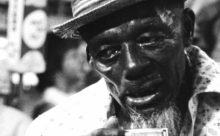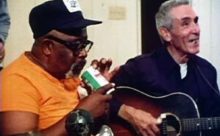About Medicine Shows
From the beginning, variety acts were a part of medicine shows. Most street workers introduced a few sleight-of-hand tricks, a comic monologue, or some banjo solos between their pitches: the Kickapoo shows of the ‘80’s and ‘90’s alternated vaudeville and circus acts with their war dances and mock powwows; even the professionally pious “Quaker” healers leavened their sermons with clog dances and minstrel routines.
After the turn of the century, the character of the medicine show began to change. Vaudeville dominated popular entertainment in cities and towns, and in rural areas medicine show companies began to place more emphasis on vaudeville acts and less on exotic atmosphere and costumes. The old-fashioned Indian, Oriental, and Quaker shows gradually became vaudeville performances interrupted by medicine lectures and sales. The 20th century medicine shows, however, were not simply small-time vaudeville with pauses for commercial messages. They developed their own unique brand of variety out of a curious mixture of vaudeville, burlesque, dime museum material, and the minstrel show.
A standard middle-sized medicine show company of the teens and early ‘20’s might include a lecturer-manager, a sketch team (both of whom also worked singly), a song and dance man, a pianist, and a blackface comedian. Others added a contortionist, a trapeze performer, a magician, or juggler. In 1920, Dr. Heber Becker advertised for a typical vaudeville company:
Blackface Singing, Dancing Comedians; must play banjo and guitar. Lady Performer; must sing and dance. Lady to handle and take care of snakes. One good Sketch Team. All people must work in acts and sign contract for season’s work.
Medicine show entertainers had to be astonishingly versatile. Shows depended heavily on repeat business during their stay in a community. To get it, they were often forced to change their bills every night for a run of one or two weeks. At least one company produced a substantially new show every night for 40 nights in a row. Since medicine show performers usually appeared two or three time a night, and sometimes more, the size of a performer’s repertoire had to be enormous. Bobby Snyder, a late performer did chalk talks, ventriloquism, rube comedy, blackface comedy, Toby acts, and magic. He also played the guitar and five-string banjo, and performed in all the afterpieces. Frank Golden performed a dozen different specialties and claimed to know by heart a hundred different blackface acts.
The blackface comic dominated most medicine show performances. Generally called Sambo or Jake, he was borrowed from the minstrel show. Like the Interlocutor of minstrelsy, Jake served as chief comedian and master of ceremonies, acting in sketches, introducing specialty numbers, playing the banjo, and cracking jokes with the straightman. Typically, Jake was dressed in an outfit not too different from the comic tramp costumes of burlesque-huge “slap shoes,” gigantic trousers held up by “extra elastic” suspenders that made the comic’s pants wobble and bounce at every step, and a shirt or jacket in some violent color combination and outlandish pattern.
The black face makeup-worn on some shows even by black performers- was ordinarily the standard theatrical supply house product. When that was not available, an acceptable substitute could be made by burning the cork from the inside of bottle caps and mixing the result with wet ashes. Apache Jack, a medicine lecturer who doubled as his own blackface comic, made up on stage as part of his act, blacking his hands and all of his face, except for white circles around his eyes and mouth, in under two minutes and gradually shifting from his “doc” voice to the typical minstrel Jake dialect.
In most troupes Jake also served as “producer” of the show. Traditionally, he bore responsibility for seeing that performers were “up in all the acts and bits” used by medicine shows and for arranging acts, bits, specialties, musical numbers, and the like into some kind of coherent evening’s bill. The medicine show, like the commedia dell’ art before it, worked largely out of an oral tradition. Material was casually borrowed from minstrel shows, vaudeville, burlesque, and the legitimate theater, and little of it was written down. The blackface comedian had to know all of the traditional medicine show material, to reconcile one performer’s version of a sketch with that of another, and constantly to cut, shape, and organize the bills out of his prodigious memory for acts and bits. Jake, a former medicine showman recalled, would take charge.
[He] would say, “Tonight we’re going to open with ‘The Black Statue’ and close with ‘Three O’Clock Train,’” and everybody on the show knew what was going on. Those people who were in between would do their various specialties, and if a town looked especially good they would add extra material to dress up the show.
A typical medicine show might last two hours and was made up of eight or 10 selections, including two or three lectures and their accompanying pitches. Most began with a banjo solo or two designed to settle the audience or a song and dance number featuring the whole cast. Frequently, the second item on the bill was a rapid-fire exchange of jokes and stock bits between the blackface comedian and the straightman. Next came more music or a specialty number-mind-reading, magic, trick shooting, perhaps a sword swallower or ventriloquist-followed by the first item pitched, often soap, since it was relatively inexpensive and could be used to put a tight-fisted audience in the mood to buy more expensive tonics and laxatives that appeared later. Another act or two followed, usually a comic bit and a musical act or specialty number, and then the second lecture and sale. Finally came another bit or specialty number, the prize candy sake, and the traditional medicine show afterpiece, almost invariable a blackface “nigger” act featuring Jake, the straightman, and a ghost.
Contest and “giveaways” were cheap to operate and worked well in place of acts and specialty numbers when the company was running low on fresh material. They also had the virtue of directly involving local people in the show-always a sure way to increase attendance. One show presented purchasers of specially marked medicine bottles with a massive gold watch chain of doubtful pedigree. T.P. Kelley ran amateur nights like those staged by many small vaudeville houses, devoting part of the program to quartettes of hymn singers, amateur animal acts, and the perennial recitations and bird call imitations. Many companies with less faith in home talent staged simple contest which depended for their success on placing a group of locals in some ludicrous situation, say a pie-eating contest using a dozen small boys from the audience. In one version the boys’ hands were tied behind their backs as they attacked pies, smeared with molasses, which dangled from the ceiling by strings, biting away pieces until the first boy to demolish an entire pie was declared the winner.
Comic songs, bits, and acts were the real heart of the performance. For the most part, medicine show comedy made few claims to subtlety or refinement. A song popular with medicine shows, for example, was “The Little Red Caboose Behind the Train,” characteristically performed by Sambo who, during the chorus, turned a lighted cigar backwards in his mouth and blew out streamers of smoke while whistling an imitation of a freight train rounding a curve.
Interspersed with the songs were jokes and quips of ancient vintage. Jingles of the “shave-and-a-haircut-six-bits” variety were traditional on many shows along with fantastic malapropisms. Borrowed from minstrel show “stump speeches” and put in the mouth of the blackface comedian. The old adage, “Don’t count your chickens before they’re hatched,” became, in Jake’s pompous dialect, “You should never speculate upon your juvenile poultry until the proper process of incubation has thoroughly materialized.”
The typical medicine show “bit” was a short, single-joke scene, usually performed by the blackface comedian and the straightman, and existing in dozens of variations on medicine shows and in minstrel companies, vaudeville, and burlesque. Some bits are nearly full-scale acts, and the line between the two types is often unclearly drawn. Acts usually were longer and more complicated, sometimes involving half-a-dozen characters. These depended less clearly on a single joke, and contained some semblance of plot. There were dozens of them. The perennial favorites, known to every medicine show performer and virtually every small-town boy of the 20th century, were “Three O’Clock Train,” “Pete in the Well,” and “Over the River, Charlie.” All three are “nigger acts,” trading on the physical dexterity and the malapropisms and mispronunciations of Jake. Probably all three had their origins in the afterpieces that closed the 19th century minstrel show.
In medicine show parlance, “act” and “afterpiece” were used interchangeably. Thus, in defiance of all apparent logic, a so-called afterpiece might appear anywhere in the show. For most spectators the afterpiece was the best part of the performance, and the announcement that one of the three traditional acts would be performed was almost guaranteed to hold an audience through tall the lectures and sales to the very end of the medicine show.
The great classic medicine show acts are all innocently chaotic and filled with the kind of violent clowning that no longer interest most audiences. And all trade on unfeeling stereotypes that are very difficult to swallow today. But in their own time and place they must have had a special power. It is probably no coincidence that so many medicine shows ended their performances with farces in which white-sheeted apparitions drifted about, bodies were dropped down wells, and ludicrous autopsies with butcher knives and handsaws held the stage. Psychiatrists say we laugh hardest at the things that frighten us. If this is so, the three famous afterpieces were nothing less than comic reminders to simple people of their own mortality-the doctor’s final harangue to the crowd.
Adapted from Brooks McNamara's book, Step Right Up (Garden City, New York: Doubleday & Co., 1976: pp. 130-155).

